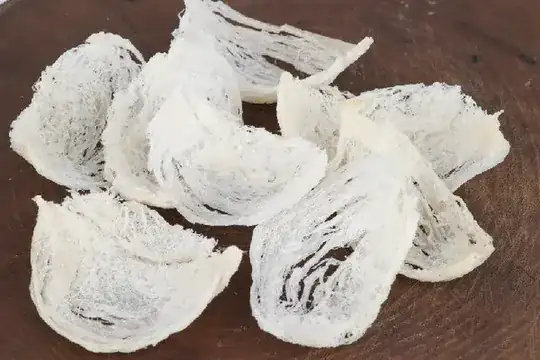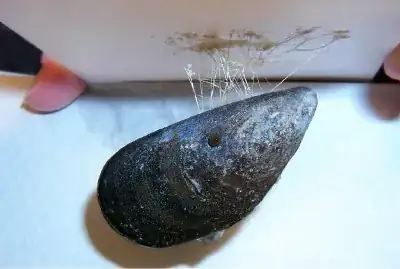Spiders produce silk, a protein fibre able to construct webs and dens. But is there an existing animal (preferably a vertebrate) that would be able to evolve a similar ability of producing a silk-like fibre?
-
7Humans do. Ever heard of nylon? It's a silk-like fibre produced by humans and commonly used for weaving nets. – AlexP Oct 01 '17 at 21:12
-
3This question suffers from a common problem with "could it evolve?" questions: given enough time anything can evolve from anything. The only true answer to your question is, "everything can." Evolution favors changes in design that benefit the creature's capacity to survive. Therefore, the question really isn't "can something evolve this way?" The question is, "what outside influences could cause something to evolve this way?" – JBH Oct 01 '17 at 23:04
-
See also Could a creature evolve a biological “bulletproof vest”? – user Oct 02 '17 at 15:22
-
1I'm reminded of a Far Side cartoon showing bison "ballooning" a la spiders... https://i.pinimg.com/originals/da/41/d8/da41d859e450280d02518bbb2c27aefc.jpg – akaioi Oct 02 '17 at 19:51
-
Would rope made of human hair count? – Oct 02 '17 at 20:04
-
Apparently goats – ATaco Oct 03 '17 at 01:37
-
@akaioi Far Side almost always has a 'hidden second joke' in the cartoon. The bison with the burst balloon falling from the sky. For every success, there is an equal and opposite failure. – Justin Thyme Oct 03 '17 at 13:59
-
@JHB: This isn’t true: “given enough time anything can evolve from anything”. There are some precise (and some vague) limits on evolvability. Creationists love to abuse this trope to argue irreducible complexity. But a stronger version of this argument is true. For example, evolution must obey physics; so no species will ever evolve high luck in chance encounters (apologies to Larry Niven). And some traits are unlikely (read, virtually impossible) to evolve since they are too complex and convey insufficient advantage (e.g. functional, high-quality eyes absent a visual cortex). – Konrad Rudolph Oct 03 '17 at 15:12
7 Answers
The edible-nest swiftlet fits the bill. It is a vertebrate. It has saliva which performs a structural function without added twigs or vegetable matter.
These little birds make nests of their gummy saliva. If the saliva is solid enough to pack together in a nest it is solid enough for strands to make a web.
from https://www.livescience.com/21534-edible-birds-nests-health.html

Probably you could make delicious soup out of the web too!
- 304,738
- 59
- 504
- 1,237
-
-
2@JAB - It's a delicacy in some countries. Gordon Ramsey did an episode on it in his show Great Escape – Taegost Oct 03 '17 at 13:56
Silkworms produce silk. Some caterpillars weave webs to protect their cocoons. Other moth and butterfly larvae, like bagworms, could also create similar structures.
- 741
- 1
- 4
- 11
https://www.youtube.com/watch?v=B0zT9CN3-50
These goats did not evolve, they were genetically modified. They have spider DNA and produce spider silk in their milk.
Maybe with some more tweaking you could get them to produce pure silk instead of the milk silk.
- 1,405
- 12
- 22
Evolution modifies existing traits as new uses emerge. Spiders use their silk to catch/immobilize prey, drift through the air, protect their eggs, and build shelters. Any of these uses could have come first, but the first one gave an evolutionary advantage.
Skunks spray in self-defense, but a new protein could make skunk spray an adhesive, which could eventually lead to skunk webs. Birds use saliva to glue together nests (like Will says), and that could turn into cobwebby, entrapping structures. Any tunneling animal, like a prairie dog, could start extending its structures aboveground, or up into trees.. given where the spinnerets are on spiders, maybe they started out with sticky excrement?
Original question: "is there an animal that could evolve to have webs?" Short answer: given evolutionary timescales, anything is possible. Start with a use case and build out.
- 1,431
- 7
- 5
The default answer I'm seeing a lot of is this:
Preheat selection pressure to 400
Bake for 1 million years or until webbed
There's certainly a point here, but I'd like to add a caveat. It has to do with scale. That is, the extrusion of silk depends heavily on the processing of the raw pre-silk fluid through spinnerets (basically molecular-level protein alignment by squeezing through narrow opening) and then braiding or weaving separate threads together. This is a very micro-scale operation, and it's unusual for a large animal to have conscious control over such a small, precise operation. Spiders are small enough that their "awareness" for lack of a better term is on that level.
I may not be explaining this well, but the short-short is that (say) a human would find himself too fumble-fingered (and his fingers too large) to handle such tiny filaments.
You could posit maybe a chain of organs where the small-scale work is done autonomously and then hands off to a larger manipulator (maybe several steps) until you get to a scale appropriate to the creature, but ... it seems a little precarious.
Note: I'm making a huge assumption here about the level of fine manipulator control being linked to creature size. I think it bears out, but feel free to challenge!
- 9,418
- 2
- 30
- 51
-
1You mean their greatest awareness. Parts of your body are aware of things that most people's conscious minds can't detect unless they hone their sensitivity to such things. Also, I don't think that spiders squirt out the silk when they exude it: I think it is pulled out from the spinnerets as a result of surface tension. – can-ned_food Oct 03 '17 at 05:17
It's all about genes. Evolution has a nasty habit of 'stealing' successful genes from some organisms and transferring them to others. Basically, anything one organism can do, so can another, if the genes transfer over. That is what Genetically Modified Organisms is all about.
Give the organism the gene to make the correct protein that will make silk (or a silk-like substance), and you have your answer.
Even humans are getting in on the act - modifying bacteria with the gene to make spider web strands, as a way to make stronger materials.
- 9,640
- 2
- 16
- 45
